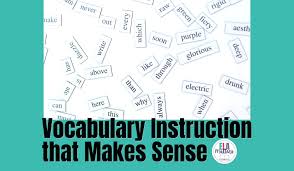I clearly remember the days when I would introduce a list of vocabulary words on Monday, have students look up the definition and write a sentence using the word during the week, and then test on Friday. Bet you can guess how miserable the results were for most students, right?
To be honest, I didn’t get much instruction on the best ways to teach vocabulary during any phase of my teacher training. It’s no surprise I fell back on the way I was taught. It turns out that was less than ideal and left both my students and me pretty frustrated.

A New Approach
After a bit of reflection, I decided to try something different. Once I started experimenting with other ways to approach vocabulary instruction, I saw a significant shift in my students’ attitude about vocabulary and their retention and proper use of our “list” of words.
First, I was able to easily enrich and build vocabulary with students in the way I interacted and questioned them daily. Many teachers think they need to dumb down language for students. The truth is, you don’t need to. I realized I was missing valuable opportunities to engage and connect when I didn’t use rich vocabulary.
Three ways I helped my students develop vocabulary through classroom interaction:
- Weaved higher-level words into my communication with students. Studies show they learn new words from context clues more successfully than the use of flashcards or drill and kill techniques. This includes the language you know appears on “the test.”
- Created a safe learning environment where students were willing to take risks with language. When students are comfortable taking risks, they will be more likely to use advanced vocabulary in both spoken and written language in their work.
- Taught students to echo my questions and language. This not only helped them clarify for understanding, but it gave them practice using the new words in the correct way.

Choice Boards
Finally, my students responded well when given choices for vocabulary work. Instead of having them look up words in the dictionary (my students do get dictionary practice at other times), I gave them the word list with the definitions included. By doing this, my students spent time using the new words in context rather than writing down definitions.
I gave students activity choices like memes, narrative stories, text messages, comic strips, poems, riddles, and scavenger hunts. Acrostic vocabulary was an easy, student-favorite that was perfect as a simple task at the beginning of the year.
Acrostic Vocabulary
Objective: Students use vocabulary words to create acrostic poems that either define the term or show its relationship to text.
Directions:
1. Introduce acrostic poems by explaining what they are and how they are written. Write a short acrostic poem together as a class.
2. Students use a list of vocabulary words for the individual poem writing activity. The words might be taken from a novel, weekly vocabulary lesson, or class reading (text, short story, etc.)
3. Students select two to three words from the list and develop an acrostic poem for each that defines the word or shows its relationship to the novel/text.
Have your students finish off the poem will illustrations and designs for an awesome classroom work display.

